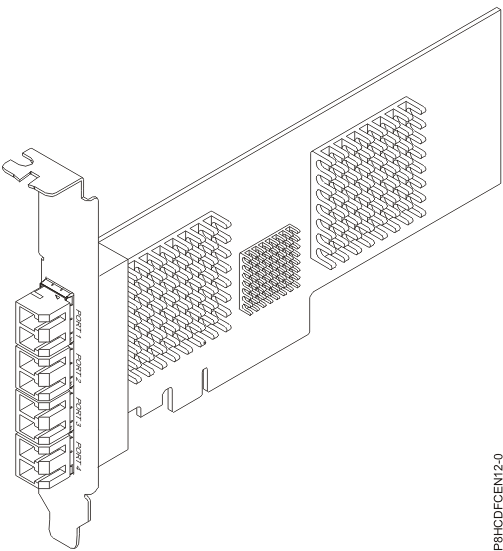PCIe2 FH 4-port 8 Gb Fibre Channel Adapter (FC EN12, CCIN EN0Y)
Learn about the specifications and operating system requirements for the feature code (FC) EN12 adapter.
Overview
The PCIe2 FH 4-port 8 Gb Fibre Channel Adapter is a PCI Express (PCIe) generation-2, full height, high-performance, x8 short form factor plus (SFF+) Host Bus Adapter (HBA). This adapter enables multiple logical (virtual) connections to share the same physical port. Each logical connection has its own resources and the ability to be managed independently. Each port provides single initiator capability over a fiber link or provides multiple initiator capability with N_Port ID Virtualization (NPIV). The ports are connected by using LC type connectors. These connectors use shortwave laser optics. The adapter operates at link speeds of 2, 4, and 8 gigabits per second (Gbps) and automatically negotiates to the highest speed possible. LEDs on each port provide information about the connection status and link speed of the port. The adapter connects to a Fibre Channel switch.

Specifications
- Item
- Description
- Adapter FRU number
- 00WT107 (Designed to comply with RoHS requirement)
- I/O bus architecture
- PCIe2.0 x8
- Slot requirement
- One PCIe generation-2 x8 slot.
- Cables
- For information about the cables, see Cables.
- Voltage
- 3.3 V and 12.0 V
- Form factor
- Short
- Maximum number
- For details about the maximum number of adapters that are supported, see PCIe adapter placement rules and slot priorities and select the system you are working on.
- Attributes provided
-
- NPIV capability is supported through VIOS.
- Requires a PCI Express generation-2 x8 slot for all four ports to operate at full speed.
For details about slot priorities and placement rules, see PCIe adapter placement rules and slot priorities and select the system you are working on.
Cables
- OM3: Multimode 50/125 micron fiber, 2000 MHz x km bandwidth
- OM2: Multimode 50/125 micron fiber, 500 MHz x km bandwidth
- OM1: Multimode 62.5/125 micron fiber, 200 MHz x km bandwidth
| Header | Cable Type and Distance | ||
|---|---|---|---|
| Rate | OM1 | OM2 | OM3 |
| 2.125 Gbps | 0.5 meters to 150 meters (1.64 feet to 492.12 feet) | 0.5 meters to 300 meters (1.64 feet to 984.25 feet) | 0.5 meters to 500 meters (1.64 feet to 1640.41 feet) |
| 4.25 Gbps | 0.5 meters to 70 meters (1.64 feet to 229.65 feet) | 0.5 meters to 150 meters (1.64 feet to 492.12 feet) | 0.5 meters to 380 meters (1.64 feet to 1246.71 feet) |
| 8.5 Gbps | 0.5 meters to 21 meters (1.64 feet to 68.89 feet) | 0.5 meters to 50 meters (1.64 feet to 164.04 feet) | 0.5 meters to 150 meters (1.64 feet to 492.12 feet) |
Operating system or partition requirements
- AIX®
- AIX 7.1 with the 7100-01 Technology Level and Service Pack 4, or later.
- AIX 7.1 with the 7100-00 Technology Level and Service Pack 6, or later.
- AIX 6.1 with the 6100-07 Technology Level and Service Pack 4, or later.
- AIX 6.1 with the 6100-06 Technology Level and Service Pack 8, or later.
- AIX 5.3 with the 5300-12 Technology Level and Service Pack 6, or later.
- Linux
- Red Hat Enterprise Linux Version 7, or later, with current maintenance updates available from Red Hat.
- Red Hat Enterprise Linux Version 6.2, or later, with current maintenance updates available from Red Hat.
- SUSE Linux Enterprise Server 11, Service Pack 2, or later, with current maintenance updates available from SUSE.
- SUSE Linux Enterprise Server 10, Service Pack 4, or later
- For support details, see the Linux Alert website.
- IBM® i only with VIOS
- IBM i Version 7.2 or later
- IBM i Version 7.1, or later
- VIOS
- VIOS support requires VIOS 2.2.1.4, or later.
